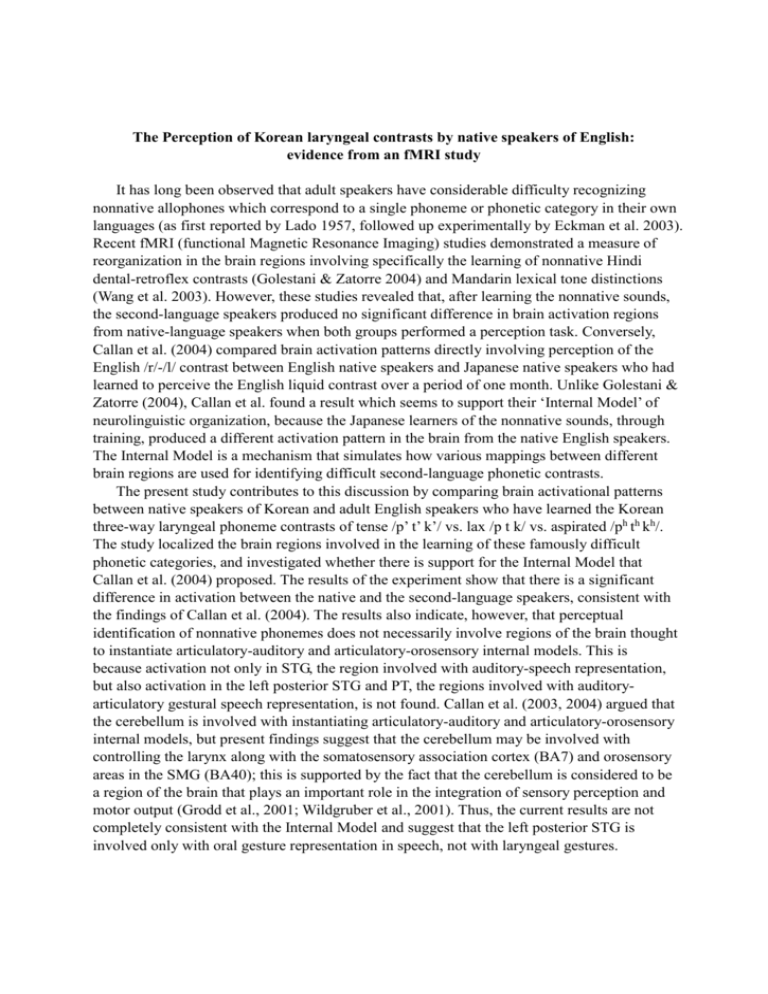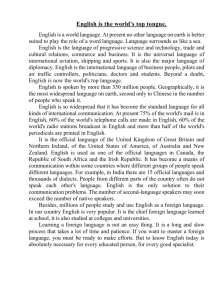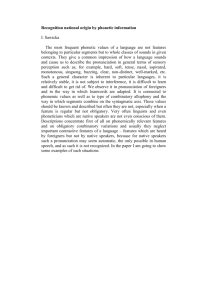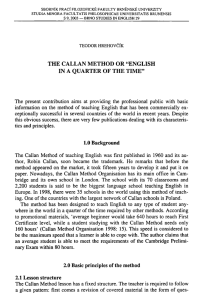The Perception of Korean laryngeal contrasts by native speakers of
advertisement

The Perception of Korean laryngeal contrasts by native speakers of English: evidence from an fMRI study It has long been observed that adult speakers have considerable difficulty recognizing nonnative allophones which correspond to a single phoneme or phonetic category in their own languages (as first reported by Lado 1957, followed up experimentally by Eckman et al. 2003). Recent fMRI (functional Magnetic Resonance Imaging) studies demonstrated a measure of reorganization in the brain regions involving specifically the learning of nonnative Hindi dental-retroflex contrasts (Golestani & Zatorre 2004) and Mandarin lexical tone distinctions (Wang et al. 2003). However, these studies revealed that, after learning the nonnative sounds, the second-language speakers produced no significant difference in brain activation regions from native-language speakers when both groups performed a perception task. Conversely, Callan et al. (2004) compared brain activation patterns directly involving perception of the English /r/-/l/ contrast between English native speakers and Japanese native speakers who had learned to perceive the English liquid contrast over a period of one month. Unlike Golestani & Zatorre (2004), Callan et al. found a result which seems to support their ‘Internal Model’ of neurolinguistic organization, because the Japanese learners of the nonnative sounds, through training, produced a different activation pattern in the brain from the native English speakers. The Internal Model is a mechanism that simulates how various mappings between different brain regions are used for identifying difficult second-language phonetic contrasts. The present study contributes to this discussion by comparing brain activational patterns between native speakers of Korean and adult English speakers who have learned the Korean three-way laryngeal phoneme contrasts of tense /p’ t’ k’/ vs. lax /p t k/ vs. aspirated /ph th kh/. The study localized the brain regions involved in the learning of these famously difficult phonetic categories, and investigated whether there is support for the Internal Model that Callan et al. (2004) proposed. The results of the experiment show that there is a significant difference in activation between the native and the second-language speakers, consistent with the findings of Callan et al. (2004). The results also indicate, however, that perceptual identification of nonnative phonemes does not necessarily involve regions of the brain thought to instantiate articulatory-auditory and articulatory-orosensory internal models. This is because activation not only in STG, the region involved with auditory-speech representation, but also activation in the left posterior STG and PT, the regions involved with auditoryarticulatory gestural speech representation, is not found. Callan et al. (2003, 2004) argued that the cerebellum is involved with instantiating articulatory-auditory and articulatory-orosensory internal models, but present findings suggest that the cerebellum may be involved with controlling the larynx along with the somatosensory association cortex (BA7) and orosensory areas in the SMG (BA40); this is supported by the fact that the cerebellum is considered to be a region of the brain that plays an important role in the integration of sensory perception and motor output (Grodd et al., 2001; Wildgruber et al., 2001). Thus, the current results are not completely consistent with the Internal Model and suggest that the left posterior STG is involved only with oral gesture representation in speech, not with laryngeal gestures. References Callan, D.E., Tajima, K., Callan, A.M., Kubo, R., Masaki, S., Akahane-Yamada, R., 2003. Learning-induced neural plasticity associated with improved identification performance after training of a difficult second language phonetic contrast. NeuroImage 19.113-124. Callan, D., Jones, J., Callan, A., Akahane-Yamada, R., 2004. Phonetic perceptual identification by native- and second-language speakers differentially activates brain regions involved with acoustic phonetic processing and those involved with articulatoryauditory/orosensory internal models. NeuroImage 22.1182-1194. Eckman, F., Elreyes, A., G. Iverson, 2003. Some principles of second language phonology. Second Language Research 19.169-208. Golestani, N., Zatorre, R.J., 2004. Learning new sounds of speech: reallocation of neural states. NeuroImage 21.494-506. Grodd, W., Hulsmann, E., Lotze, M., Wildgruber, D., Erb, M., 2001. Sensorimotor mapping of the human cerebellum: fMRI evidence of somatotopic organization. Human Brain Mapping 13.55-73. Lado, R. 1957. Linguistics Across Cultures: Applied Linguistics for Language Teachers. Ann Arbor: University of Michigan Press. Wang, Y., Sereno, J.A., Jongman, A., Hirsch, J., 2003. fMRI evidence for cortical modification during learning of mandarin lexical tone. Journal of Cognitive Neuroscience 15.1019-1027.









